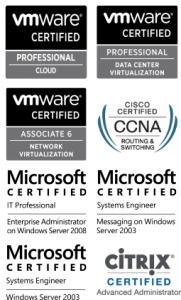Scenario
You’ve just installed Exchange 2010 and now you want to migrate from Exchange 2007 to Exchange 2010.
Here’s the steps I took.
Tips, thoughts and notes from the world of IT
You’ve just installed Exchange 2010 and now you want to migrate from Exchange 2007 to Exchange 2010.
Here’s the steps I took.
To find out the version and build number of Exchange 2007/2010, you can do one of the following:


This will give you the major version and service pack version numbers – in my case it major version 8 (aka Exchange 2007) and Service Pack 3.
To find out the Update Rollup version, navigate to Control Panel > Programs > View Installed updates on your Exchange Server:
I got the following error whilst trying to log into a user’s mailbox via Outlook Web Access:
Request Url: https://mail.domain.local:443/owa/lang.owa User host address: 123.123.123.123
Exception Exception type: Microsoft.Exchange.Data.Storage.StoragePermanentException Exception message: There was a problem accessing Active Directory.
Call stack
Microsoft.Exchange.Data.Storage.ExchangePrincipal.Save() Microsoft.Exchange.Clients.Owa.Core.RequestDispatcher.DispatchLanguagePostLocally(OwaContext owaContext, OwaIdentity logonIdentity, CultureInfo culture, String timeZoneKeyName, Boolean isOptimized) Microsoft.Exchange.Clients.Owa.Core.RequestDispatcher.DispatchLanguagePostRequest(OwaContext owaContext) Microsoft.Exchange.Clients.Owa.Core.RequestDispatcher.PrepareRequestWithoutSession(OwaContext owaContext, UserContextCookie userContextCookie) Microsoft.Exchange.Clients.Owa.Core.RequestDispatcher.InternalDispatchRequest(OwaContext owaContext) Microsoft.Exchange.Clients.Owa.Core.RequestDispatcher.DispatchRequest(OwaContext owaContext) System.Web.HttpApplication.SyncEventExecutionStep.System.Web.HttpApplication.IExecutionStep.Execute() System.Web.HttpApplication.ExecuteStep(IExecutionStep step, Boolean& completedSynchronously)
Inner Exception Exception type: Microsoft.Exchange.Data.Directory.InvalidADObjectOperationException Exception message: Property Languages cannot be set on this object because it requires the object to have version 0.1 (8.0.535.0) or later. Current version of the object is 0.0 (6.5.6500.0).
Call stack
Microsoft.Exchange.Data.Directory.PropertyBag.set_Item(PropertyDefinition key, Object value) Microsoft.Exchange.Data.Directory.ADObject.set_Item(PropertyDefinition propertyDefinition, Object value) Microsoft.Exchange.Data.Directory.ADObject.StampCachedCaculatedProperties(Boolean retireCachedValue) Microsoft.Exchange.Data.Directory.ADObject.ValidateWrite(List`1 errors) Microsoft.Exchange.Data.Directory.Recipient.ADRecipient.ValidateWrite(List`1 errors) Microsoft.Exchange.Data.Directory.Recipient.ADUser.ValidateWrite(List`1 errors) Microsoft.Exchange.Data.Directory.ADSession.Save(ADObject instanceToSave, IEnumerable`1 properties) Microsoft.Exchange.Data.Storage.ExchangePrincipal.Save()
Turns out a mailbox attribute version was wrong:
Exchange Server 2007 and Exchange Server 2010 both use the msExchVersion attribute to determine the version of Exchange Server with which user objects are associated. If the version value is less than 0.1, Exchange Server 2007 or Exchange Server 2010 considers the user object as Read-only.
Find out the attribute version by running:Get-Mailbox [username] | format-list ExchangeVersion
And fix by running:Set-Mailbox [username] -ApplyMandatoryProperties
Find out more here: http://support.microsoft.com/kb/941146
Although the POP and IMAP services are disabled by default in Exchange 2007, every mailbox will have the features enabled. This means everyone will be able to use POP and IMAP if you enable the services. What if you only want a few users to use them?
Use this PowerShell cmdlet to disable POP and IMAP for all users in Exchange 2007/2010:
Get-CASMailbox | Set-CASMailbox -PopEnabled $false -ImapEnabled $false
You can then enable the POP and IMAP features for specific users via the GUI or by using this cmdlet:
Set-CASMailbox -Identity adam.rush -PopEnabled $true -ImapEnabled $true

Copyright © 2019 · Enterprise Child Theme on Genesis Framework · WordPress · Log in